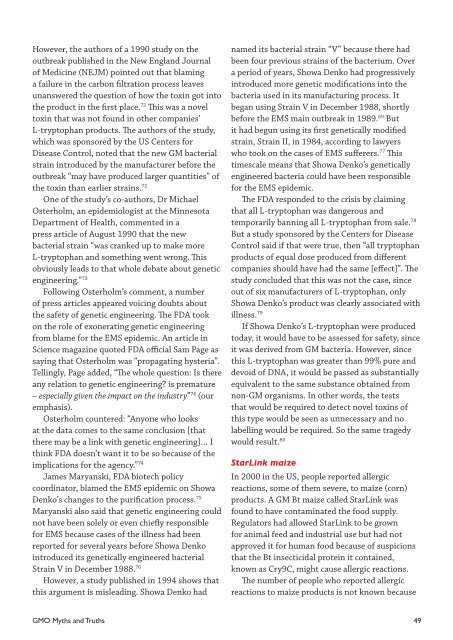GMO Myths and Truths
GMO Myths and Truths
GMO Myths and Truths
Create successful ePaper yourself
Turn your PDF publications into a flip-book with our unique Google optimized e-Paper software.
However, the authors of a 1990 study on the<br />
outbreak published in the New Engl<strong>and</strong> Journal<br />
of Medicine (NEJM) pointed out that blaming<br />
a failure in the carbon filtration process leaves<br />
unanswered the question of how the toxin got into<br />
the product in the first place. 72 This was a novel<br />
toxin that was not found in other companies’<br />
L-tryptophan products. The authors of the study,<br />
which was sponsored by the US Centers for<br />
Disease Control, noted that the new GM bacterial<br />
strain introduced by the manufacturer before the<br />
outbreak “may have produced larger quantities” of<br />
the toxin than earlier strains. 72<br />
One of the study’s co-authors, Dr Michael<br />
Osterholm, an epidemiologist at the Minnesota<br />
Department of Health, commented in a<br />
press article of August 1990 that the new<br />
bacterial strain “was cranked up to make more<br />
L-tryptophan <strong>and</strong> something went wrong. This<br />
obviously leads to that whole debate about genetic<br />
engineering.” 73<br />
Following Osterholm’s comment, a number<br />
of press articles appeared voicing doubts about<br />
the safety of genetic engineering. The FDA took<br />
on the role of exonerating genetic engineering<br />
from blame for the EMS epidemic. An article in<br />
Science magazine quoted FDA official Sam Page as<br />
saying that Osterholm was “propagating hysteria”.<br />
Tellingly, Page added, “The whole question: Is there<br />
any relation to genetic engineering? is premature<br />
– especially given the impact on the industry” 74 (our<br />
emphasis).<br />
Osterholm countered: “Anyone who looks<br />
at the data comes to the same conclusion [that<br />
there may be a link with genetic engineering]… I<br />
think FDA doesn’t want it to be so because of the<br />
implications for the agency.” 74<br />
James Maryanski, FDA biotech policy<br />
coordinator, blamed the EMS epidemic on Showa<br />
Denko’s changes to the purification process. 75<br />
Maryanski also said that genetic engineering could<br />
not have been solely or even chiefly responsible<br />
for EMS because cases of the illness had been<br />
reported for several years before Showa Denko<br />
introduced its genetically engineered bacterial<br />
Strain V in December 1988. 76<br />
However, a study published in 1994 shows that<br />
this argument is misleading. Showa Denko had<br />
named its bacterial strain “V” because there had<br />
been four previous strains of the bacterium. Over<br />
a period of years, Showa Denko had progressively<br />
introduced more genetic modifications into the<br />
bacteria used in its manufacturing process. It<br />
began using Strain V in December 1988, shortly<br />
before the EMS main outbreak in 1989. 69 But<br />
it had begun using its first genetically modified<br />
strain, Strain II, in 1984, according to lawyers<br />
who took on the cases of EMS sufferers. 77 This<br />
timescale means that Showa Denko’s genetically<br />
engineered bacteria could have been responsible<br />
for the EMS epidemic.<br />
The FDA responded to the crisis by claiming<br />
that all L-tryptophan was dangerous <strong>and</strong><br />
temporarily banning all L-tryptophan from sale. 78<br />
But a study sponsored by the Centers for Disease<br />
Control said if that were true, then “all tryptophan<br />
products of equal dose produced from different<br />
companies should have had the same [effect]”. The<br />
study concluded that this was not the case, since<br />
out of six manufacturers of L-tryptophan, only<br />
Showa Denko’s product was clearly associated with<br />
illness. 79<br />
If Showa Denko’s L-tryptophan were produced<br />
today, it would have to be assessed for safety, since<br />
it was derived from GM bacteria. However, since<br />
this L-tryptophan was greater than 99% pure <strong>and</strong><br />
devoid of DNA, it would be passed as substantially<br />
equivalent to the same substance obtained from<br />
non-GM organisms. In other words, the tests<br />
that would be required to detect novel toxins of<br />
this type would be seen as unnecessary <strong>and</strong> no<br />
labelling would be required. So the same tragedy<br />
would result. 80<br />
StarLink maize<br />
In 2000 in the US, people reported allergic<br />
reactions, some of them severe, to maize (corn)<br />
products. A GM Bt maize called StarLink was<br />
found to have contaminated the food supply.<br />
Regulators had allowed StarLink to be grown<br />
for animal feed <strong>and</strong> industrial use but had not<br />
approved it for human food because of suspicions<br />
that the Bt insecticidal protein it contained,<br />
known as Cry9C, might cause allergic reactions.<br />
The number of people who reported allergic<br />
reactions to maize products is not known because<br />
<strong>GMO</strong> <strong>Myths</strong> <strong>and</strong> <strong>Truths</strong> 49


